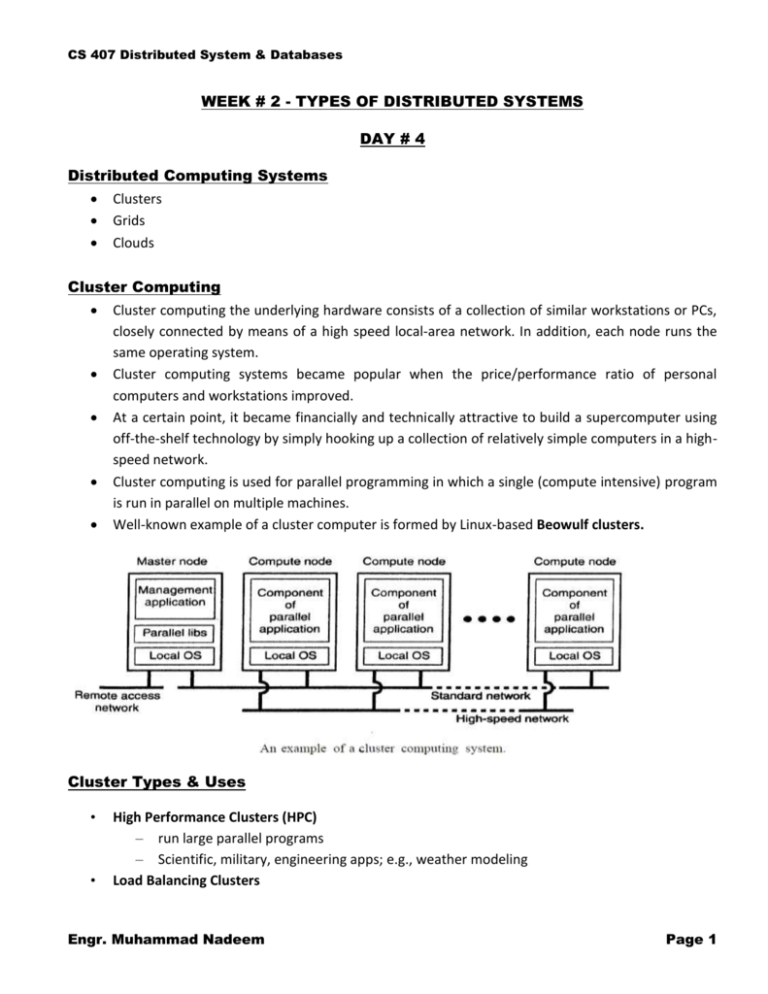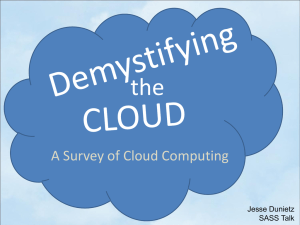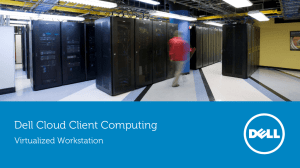Week 2
advertisement

CS 407 Distributed System & Databases WEEK # 2 - TYPES OF DISTRIBUTED SYSTEMS DAY # 4 Distributed Computing Systems Clusters Grids Clouds Cluster Computing Cluster computing the underlying hardware consists of a collection of similar workstations or PCs, closely connected by means of a high speed local-area network. In addition, each node runs the same operating system. Cluster computing systems became popular when the price/performance ratio of personal computers and workstations improved. At a certain point, it became financially and technically attractive to build a supercomputer using off-the-shelf technology by simply hooking up a collection of relatively simple computers in a highspeed network. Cluster computing is used for parallel programming in which a single (compute intensive) program is run in parallel on multiple machines. Well-known example of a cluster computer is formed by Linux-based Beowulf clusters. Cluster Types & Uses • • High Performance Clusters (HPC) – run large parallel programs – Scientific, military, engineering apps; e.g., weather modeling Load Balancing Clusters Engr. Muhammad Nadeem Page 1 CS 407 Distributed System & Databases • – Front end processor distributes incoming requests – server farms (e.g., at banks or popular web site) High Availability Clusters (HA) – Provide redundancy – backup systems – May be more fault tolerant than large mainframes Grid Computing Grid computing consists of distributed systems that are often constructed as a federation of computer systems, where each system may fall under a different administrative domain, and may be very different when it comes to hardware, software, and deployed network technology. A key issue in a grid computing system is that resources from different organizations are brought together to allow the collaboration of a group of people or institutions. Such collaboration is realized in the form of a virtual organization. The people belonging to the same virtual organization have access rights to the resources that are provided to that organization. Cloud Computing Provides scalable services as a utility over the Internet. Cloud computing means you develop/run your software remotely on remote platform. This can be either using remote virtual infrastructure (amazon EC2), remote platform (google app engine), or remote application (force.com or gmail.com). Engr. Muhammad Nadeem Page 2 CS 407 Distributed System & Databases Using Cloud Computing, companies can scale upto High capacities immediately without investing in new infrastructure, training the people or new software licensing. It is more useful for small and medium scale businesses who want to outsource their Data Center infrastructure, or some larger companies also prefer if they want to cut down the costs of building data-centers internally in order to get peak load capacity. In short, consumers use what they need and pay accordingly. Additional advantages for the consumer are, they no longer has to be at a computer to use the application. They can access it by using smart phones, PDA or which the medium Cloud supports. By adopting cloud, consumer does not need to own the infrastructure, software and also consumer doesn’t need to worry about the network maintenance. By choosing this he can reduce the capital expenses, upfront costs and operating expenses. Difference between Cluster Computing Systems and Grid Computing Systems A characteristic feature of cluster computing is its homogeneity. In most cases, the computers in a cluster are largely the same, they all have the same operating system, and are all connected through the same network. In contrast, grid computing systems have a high degree of heterogeneity: no assumptions are made concerning hardware, operating systems, networks, administrative domains, security policies, etc. Difference between Parallel and Distributed Computing In parallel computing, all processors may have access to a shared memory to exchange information between processors. Engr. Muhammad Nadeem Page 3 CS 407 Distributed System & Databases In distributed computing, each processor has its own private memory (distributed memory). Information is exchanged by passing messages between the processors. WEEK # 2 - TYPES OF DISTRIBUTED SYSTEMS DAY # 5 Distributed Information Systems • • • Business-oriented Systems to make a number of separate network applications interoperable and build “enterprisewide information systems”. Two types discussed here: – Transaction processing systems – Enterprise application integration (EAI) Transaction Processing Systems • Provide a highly structured client-server approach for database applications • Transactions are the communication model • Obey the ACID properties: o Atomic: all or nothing o Consistent: invariants are preserved o Isolated (serializable) o Durable: committed operations can’t be undone Engr. Muhammad Nadeem Page 4 CS 407 Distributed System & Databases Transactions • Transaction processing may be centralized (traditional client/server system) or distributed. • A distributed database is one in which the data storage is distributed – connected to separate processors. Nested Transactions • A nested transaction is a transaction within another transaction (a sub-transaction) – Example: a transaction may ask for two things (e.g., airline reservation info + hotel info) which would spawn two nested transactions • Primary transaction waits for the results. – While children are active parent may only abort, commit, or spawn other children Engr. Muhammad Nadeem Page 5 CS 407 Distributed System & Databases Implementing Transactions • Conceptually, private copy of all data • Actually, usually based on logs • Multiple sub-transactions – commit, abort – Durability is a characteristic of top-level transactions only • Nested transactions are suitable for distributed systems – Transaction processing monitor may interface between client and multiple data bases. Enterprise Application Integration • Less structured than transaction-based systems • EA components communicate directly – Enterprise applications are things like HR data, inventory programs, … – May use different OSs, different DBs but need to interoperate sometimes. • Communication mechanisms to support this include CORBA, Remote Procedure Call (RPC) and Remote Method Invocation (RMI) WEEK # 2- FILE DOWNLOAING LAB DAY # 6 Engr. Muhammad Nadeem Page 6 CS 407 Distributed System & Databases Difference between Cluster Computing Systems and Grid Computing Systems In cluster computing, a bunch of similar (or identical) computers are hooked up locally (in the same physical location, directly connected with very high speed connections) to operate as a single computer. The computers that make up the cluster cannot be operated independently as separate computers. A cluster, as far as any software or other computer is concerned, looks like essentially one big computer. In grid computing, the computers do not have to be in the same physical location and can be operated independently. As far as other computers are concerned each computer on the grid is a distinct computer. Computers on a network have a program on them that allows unused resources (usually processing time and memory) to be used by another computer on the network. The speed of the connections between the computers on the grid are relatively slow (Ethernet speeds) compared to the speed of connections inside each computer, so processing tasks are broken up into independent chunks and sent out to different computers on the grid. When a computer is done with a chunk, it sends the results back to the server. Cluster differs from Cloud and Grid in that a cluster is a group of computers connected by a local area network (LAN), whereas cloud and grid are more wide scale and can be geographically distributed. Another way to put it is to say that a cluster is tightly coupled, whereas a Grid or a cloud is loosely coupled. Also, clusters are made up of machines with similar hardware, whereas clouds and grids are made up of machines with possibly very different hardware configurations. Cloud Computing refers to both the applications delivered as services over the Internet and the hardware and systems software in the datacenters that provide those services. The services themselves have long been referred to as Software as a Service (SaaS). The datacenter hardware and software is what we call a Cloud. When a Cloud is made available in a pay-as-you-go manner to the general public, we call it a Public Cloud; the service being sold is Utility Computing. We use the term Private Cloud to refer to internal datacenters of a business or other organization, not made available to the general public. Thus, Cloud Computing is the sum of SaaS and Utility Computing, but does not include Private Clouds. People can be users or providers of SaaS, or users or providers of Utility Computing. DIFFERENCE BETWEEN A CLOUD AND A GRID COMPUTING The difference between a cloud and a grid can be expressed as below: 1. Resource distribution: Cloud computing is a centralized model whereas grid computing is a decentralized model where the computation could occur over many administrative domains. 2. Ownership: A grid is a collection of computers which is owned by multiple parties in multiple locations and connected together so that users can share the combined power of resources. Whereas a cloud is a collection of computers usually owned by a single party. Examples of Clouds: Amazon Web Services (AWS), Google App Engine Examples of Grids: FutureGrid, Berkeley’s Open Infrastructure for Network Computing (BOINC) Dropbox, Gmail, Facebook, Youtube, Rapidshare, etc are all examples of cloud computing services. Engr. Muhammad Nadeem Page 7 CS 407 Distributed System & Databases LOOSELY-COUPLED SYSTEMS Each system was a completely autonomous independent system, connected to others on the network – FTP (rcp): file transfer program – telnet (rlogin/rsh): remote login program – mail (SMTP) Even today, most distributed systems are looselycoupled (although not that loosely!): – each CPU runs an independent autonomous OS – computers don’t really trust each other – some resources are shared, but most are not – the system may look differently from different hosts CLOSELY-COUPLED SYSTEMS • A distributed system becomes more “closely-coupled” as it – appears more uniform in nature – runs a “single” operating system – has a single security domain – shares all logical resources (e.g., files) – shares all physical resources (CPUs, memory, disks, printers, etc.) TIGHTLY-COUPLED SYSTEMS • A “tightly-coupled” system usually refers to a multiprocessor – runs a single copy of the OS with a single workload queue – has a single address space – usually has a single bus or backplane to which all processors and memories are connected – has very low communication latency – processors communicate through shared memory Example: two CPU chips on the same printed circuit board and connected by wires etched onto the board are likely to be tightly coupled, whereas two computers connected by a 2400 bit/sec modem over the telephone system are certain to be loosely coupled. Engr. Muhammad Nadeem Page 8







